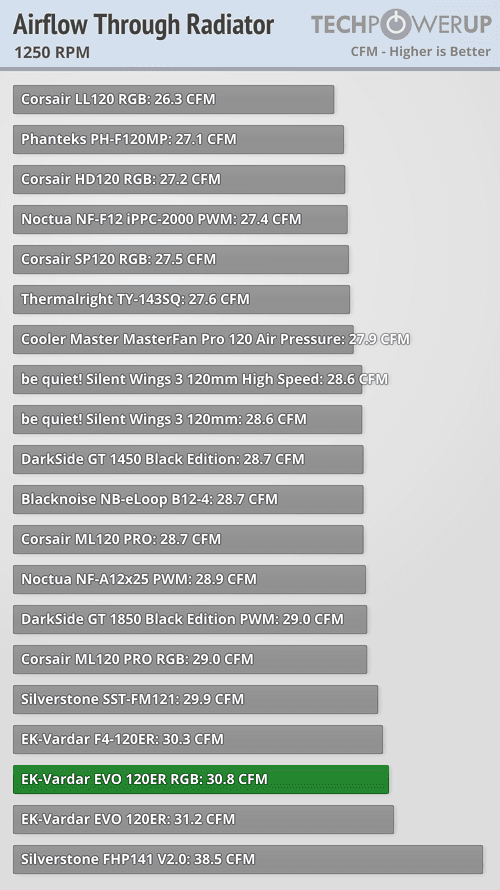 3
3
EK-Vardar EVO 120ER RGB Fan Review
Value & Conclusion »Performance Testing
Please refer to the dedicated test setup page (link here) as it applies to this review as well and I did not want to go over it separately again.Let us remind ourselves that the fan is rated for 500–2200 RPM (+/- 10%). All the provided fan samples collectively hit an average 2141 RPM at 100% PWM duty cycle and went down to an average 345 RPM at 27% PWM duty cycle before turning off completely. This is no bug, and EKWB calls it the 0 dB start-stop functionality. These fans will turn off at lower duty cycles thus, with the exact number depending on the specific PWM controller and header used. This means you get complete silence from these fans, and the graph above goes to 19 dBA because that is the floor's ambient in my anechoic chamber used for testing. In order to turn them back up, increase the PWM duty cycle percentage, but note that this means startup boost for current draw is now added, so if you plan on using this feature, account for the worst case power-draw scenario or use a PWM-powered splitter.
Other than that, these four fans had an average response across a long 27%–100% duty cycle, one close enough to the rated speed range to where I have no complaints. The standard deviation between the fan samples is higher than the non-RGB EK-Vardar EVO 120ER fan but small enough to where it is not really a concern in practice. The RPM response is also very linear, which is good to see. Alongside it, I have mapped the RPM response curves for this fan vs. the older EK-Vardar EVO 120ER as well as the even older EK-Vardar F4-120ER and EK-Vardar F4-120 fans, and we see a consistent improvement with each release up to the EVO series to where we now have both an extended range of control and EKWB's zero-RPM mode.
Context is needed to talk more about the fan's performance and noise, so I have below comparison charts for some fans tested so far at set RPM values (or as near as they can get to those).








I have included fans in charts where the rated RPM is within 50 RPM of the chart cutoff point, which means that some fans are in specific charts only if their rated speed is over 50 RPM off from a threshold value (Corsair SP120 RGB, for example) or they simply do not slow down enough (NB-eLoop B12-4, for example). Similarly, the specific RPM values chosen reflect usage scenarios most popular with watercooling, although some fans (this very EK-Vardar EVO 120ER RGB, for instance) go higher. The charts are to be considered for comparison within this result set only and are not to be compared with results from another test elsewhere owing to different testing conditions.
EKWB's plan with this fan was to essentially take the already excellent Vardar EVO 120ER and modify it for RGB lighting without sacrificing performance. As it stands, there were a few things done here that do affect how the final product turned out. Firstly, the bearing here is a dual ball-bearing vs. the hydrodynamic bearing with the non-RGB version, and we do see that it is slightly louder on average, especially so at the lower fan speeds where bearing noise can be heard over airflow noise. Secondly, the smaller hub meant that the impeller itself was not very compromised in terms of blade length, although they did have to use a different material altogether. As it is, this RGB version is close, but overall slightly worse in terms of performance/noise compared to the non-RGB Vardar EVO 120ER fan. Overall, however, it remains an excellent radiator fan that has performance as its priority.
Jul 13th, 2025 03:03 CDT
change timezone
Latest GPU Drivers
New Forum Posts
- Best motherboards for XP gaming (117)
- 9800x3D - 6400 CL32 1:1 not stable (13)
- Archival HDD constantly starting up for no reason (0)
- 6400c30 vs 8000c36 Ryzen 9800X3D (1)
- 9070XT BIOS flash (what to use?) (6)
- New ToS of Take Two and 2K (12)
- Radeon RX 6700, 6700 XT & 6750 XT users club (1138)
- Is there a WIFI chip I should get? (1)
- What are you playing? (23945)
- 9060 XT 16GB or 6800 XT/6900XT? (30)
Popular Reviews
- Fractal Design Epoch RGB TG Review
- Lexar NM1090 Pro 4 TB Review
- Corsair FRAME 5000D RS Review
- Our Visit to the Hunter Super Computer
- NVIDIA GeForce RTX 5050 8 GB Review
- NZXT N9 X870E Review
- Sapphire Radeon RX 9060 XT Pulse OC 16 GB Review - An Excellent Choice
- AMD Ryzen 7 9800X3D Review - The Best Gaming Processor
- Upcoming Hardware Launches 2025 (Updated May 2025)
- Chieftec Iceberg 360 Review
TPU on YouTube
Controversial News Posts
- Intel's Core Ultra 7 265K and 265KF CPUs Dip Below $250 (288)
- Some Intel Nova Lake CPUs Rumored to Challenge AMD's 3D V-Cache in Desktop Gaming (140)
- AMD Radeon RX 9070 XT Gains 9% Performance at 1440p with Latest Driver, Beats RTX 5070 Ti (131)
- NVIDIA Launches GeForce RTX 5050 for Desktops and Laptops, Starts at $249 (120)
- NVIDIA GeForce RTX 5080 SUPER Could Feature 24 GB Memory, Increased Power Limits (115)
- Microsoft Partners with AMD for Next-gen Xbox Hardware (105)
- Intel "Nova Lake‑S" Series: Seven SKUs, Up to 52 Cores and 150 W TDP (100)
- NVIDIA DLSS Transformer Cuts VRAM Usage by 20% (97)

